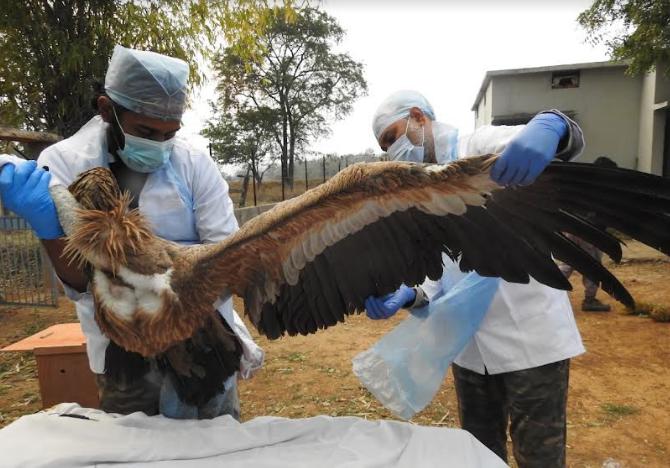Winged visitors of Panna national park have reached home –safely. In about two months of time, Himalayan Griffon vultures covered a distance of a few thousand kms to reach home in Chinese territory. While doing so, they crossed over the Himalayas .The amazing flight and its route was revealed after Geo-tagging of a near- threatened scavenger bird by a group of scientists and foresters in Panna tiger reserve in February 2022. Flying almost 120 kms every day, they reached home, the data revealed. That the vultures’ annual migration for four months to Panna from such a long distance shows the unique character of their habitat in Panna , all set to be submerged in Ken Betwa river link project which is still awaiting several green clearances.
Unique Habitat of Himalayan Vultures to Submerge in Ken Betwa project
Also read: Ken-Betwa Project:Dam of Doom for Panna Tiger Reserve
When Himalayan Griffons migrate to Panna during the winters, they spend their time mainly at the famous cliffs, habitat of 750 vultures of six species. For them Panna is their second home. The unique terrain of Panna national park consists of extensive plateaus, rocky cliffs, gorges, caves and rock crevices creating critical habitats for breeding and resting of the key species such as tiger, leopard, hyena, sloth bear and vultures. A large part of them is all set to be submerged once the Ken Betwa linking project is implemented. “ The project proponents must take into account all the ecological and environmental aspects. They should give a second thought before going ahead with the project”, a senior official of the WII said.
Geo Tagging is Like Smart Watch
The vultures were tagged with sophisticated GPS tags, known as e-ObsTags and act like a smartwatch that humans use while exercising ,walking and sleeping and get a variety of data related to the individual. The tags, manufactured in Germany, are solar-powered and weigh between 25 g and 75 g, which is quite light in weight compared to the birds that weigh over 12 kg. The tags were configured to collect and store data and then transmit the data whenever they come in the transmission link. Officials explained that “it is a GSM-based tag and data is transmitted when the birds take flight and soar.
Also Read: Future Tense: Turbulent Time Ahead for Panna Tigers
Moreover, it collects data every five minutes, allowing fine scale data along with elevation, temperature and activity among others.” After the geo tagging, the agency providing the technical support with a worldwide network, monitored the data and after analysis handed it over to the park management. The data was downloaded in the mobile networks of different geographical regions while on way to their destination. Because the tagging involved both resident and migratory vultures, the movement data will allow the wildlife conservationists to understand the migration pattern , foraging ,places where the vultures go for feeding and roosting. This information in turn helps the conservation and protection interventions.
Vultures Doing Invaluable Ecosystem Service
Himalayan vultures are susceptible to toxicity induced by diclofenac, a drug whose residues in domestic animal carcasses has led to rapid declines in populations of other Gyps vultures across Asia.The adaptation that allows this species to fly so high is an alteration of one of its proteins, which allows the bird to fly efficiently despite lower pressure and available oxygen. This is one of the largest vultures of Asia, able to reach a wingspan of about 3 meters and weighing more than 10 kg.The body structure allows them to undertake long flights.
Also Read: Egyptian Vultures: Victims of Myths And Misconceptions
Feeding exclusively on carcasses of dead animals, especially of domestic yaks, the Himalayan Griffon Vulture is in competition not only with birds but also with wolves, Snow Leopards and other carnivores. The geo tagging will also provide invaluable ecosystem services by enhancing the flow of nutrients within food webs and reducing transmission of infectious disease through the removal of carrion.
Representational Cover Image: Animalia.bio, Geo-tagging image :Panna tiger resrve ,Last Image: discoverwildlife.com





Comments
Post a Comment